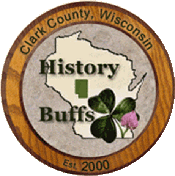Business: Plautz Brothers
Incorporated
Transcriber:
stan@wiclarkcountyhistory.org
Surnames: Plautz, Dergance, Pratt, Seliskar, Pakiz, Boe, Skora
----Source: Family Scrapbook
From pick and shovel, onto and off old time trucks, the pit-run gravel from
river bottoms and pits, to mechanized end-loaders and the latest earth moving
machinery — washed sand and gravel for road building, concrete culverts and Land
Clearing.
The story of "Plautz Brothers"
In the late 1920's Joe Plautz bought a stake rack truck (Chevrolet), with which
he hauled surplus potatoes from Willard to Milwaukee. On his return trip he
brought back grapes which were sold mainly for making wine, a tradition the
Slovenes of the area had brought with them from Europe.
In 1929, Mr. Matt Dergance, who was then the Chairman of the Town of Hendren,
asked Joe if he could haul some gravel for the township with his truck. Joe was
interested and hired his brothers Frank and Mike to help shovel the gravel on
and off the truck.
In 1930 Joe and his brother John formed a partnership. Pratt's Blacksmith shop
of Loyal built them two gravity dump boxes entirely of wood. One was mounted on
Joe's Chevrolet and the other on a new truck that John had purchased.
The boxes held 1 1/2 yards of gravel and were dumped by unhooking the front of
the box. The weight of the gravel then tipped the box back. Gravel, of course,
was dumped on a heap and had to be spread by hand. These trucks rolled on 30"x6"
single wheels. With loads heavy on the back end, it was quite an experience to
drive them up an incline, especially in and out of the pits. In 1931 the Anthony
Company came out with a rack and pinion mechanism that lifted the front end of
the box.
Their operation for the first five years was all hand loading. Then they made a
"trap" with a conveyor underneath to take gravel up to the trucks. To feed the
gravel into the trap, they bought a "tumble bug" drawn by a "10" Caterpillar. It
was driven over the trap and then the gravel was dumped. This did not have
enough power so they went back to horses and slushers.
Not being satisfied with this system, they then inquired about a "drag line",
operated by a system of cables and pulleys. They decided to make a trade for a
"20" Caterpillar which was guaranteed to pull their scraper. Now they were able
to move 400 to 500 yards of gravel daily, instead of a hundred yards daily by
hand. This was the end of manual handling of gravel.
In 1931 dual wheels were available (30"x5"). 193S brought about the hydraulic
system of lifts, which was more durable for dumping loads than the older
mechanical systems. There was a huge potential in this business and the partners
kept expanding from their small beginning of moving gravel to building roads.
When Caterpillars with bulldozers became available, clearing land became another
business venture. A breaking-plow was purchased for custom plowing. A plant was
set up for crushing, grading and washing gravel at the former Jorenby pit six
miles southeast of Willard. Concrete culverts from 12 to 72 inches in diameter
were manufactured in a plant near the main office site, six miles northwest of
Willard.
During the winter months, township roads were not plowed. In order to carry on
business transactions, Joe and John walked the four miles from their homes to
County Trunk G where their cars were parked. This inconvenience led them to
purchase an outdated snowplow for their "20" Caterpillar. The plow was assembled
with rivets because welding of this type was unheard of then in this area.
This old Caterpillar plow was mechanically operated and not as simple to operate
as the newer hydraulic models. They could then keep roads open from their homes
to County G. This branched to plowing roads for individual farmers. Eventually
the town called a special meeting and approved the plowing of all the township
roads.
This business also expanded to include another larger "Cat" plow, plus, truck
mounted plows, both large and small and also patrol mounted plows. With this
equipment they kept 260 miles of roads open in eight townships.
From these beginnings, Plautz Brothers expanded through the years to eventually
operate a fleet of twenty- four tandem drive dump trucks, single axle dump
trucks, two heavy equipment trailers, ten large Caterpillar trac¬tors, six
stone-crushers, two gravel washing plants, eight power shovels, fifteen
front-end loaders, four auto patrol graders and two pull-type graders for road
building.
They also owned many types of associated equipment, such as drills for blasting
rock formations, air- compressors, welders, electrical generators and service
trucks.
In pointing out the contrast in the technicalities of business dealings of the
past and present, Joe recalls that in the early days they drove to Eau Claire to
inquire about buying a Caterpillar at Nagel-Hart. The transaction was completed,
the Cat loaded on their trailer - no money down - no papers to sign. They were
accorded a congenial police escort out of town, all on Sunday afternoon. At one
time they employed about 100 men, among them at various periods their five
brothers and several of their nephews.
Brother Steve was the first bookkeeper for Plautz Brothers and worked for them
many years as did Amos Boe. Philip Seliskar later did office work for them until
his death.
In recent years Adam Skora took over bookkeeping duties and at present is
employed by them. Various assistants were also employed throughout the years.
Joe and George Plautz now operate the business on a much smaller scale. A heavy
equipment auction was held in May 1980 and most of the big machines were sold.
They deal now mainly in selling gravel from their many holdings in the area.
As told to Frank Pakiz by Joe Plautz, March 1981
